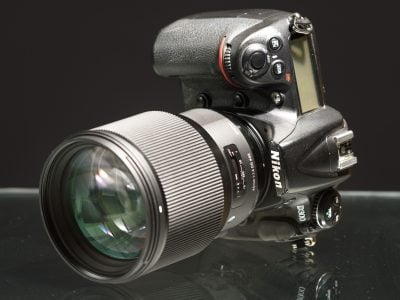Sigma 85mm f1.4 Art review
-
-
Written by Thomas
Quality
Testing: Longitudinal Chromatic Aberration and focus shift
With lenses offering an aperture of f2.8 or larger I test for longitudinal CA (loCA, a.k.a. “axial color” or “bokeh CA”). The new Sigma shows some magenta coloration in the foreground (left) and greenish hues in the background (right). By f4.0 the effect is almost gone. The test also revealed very little focus shift.
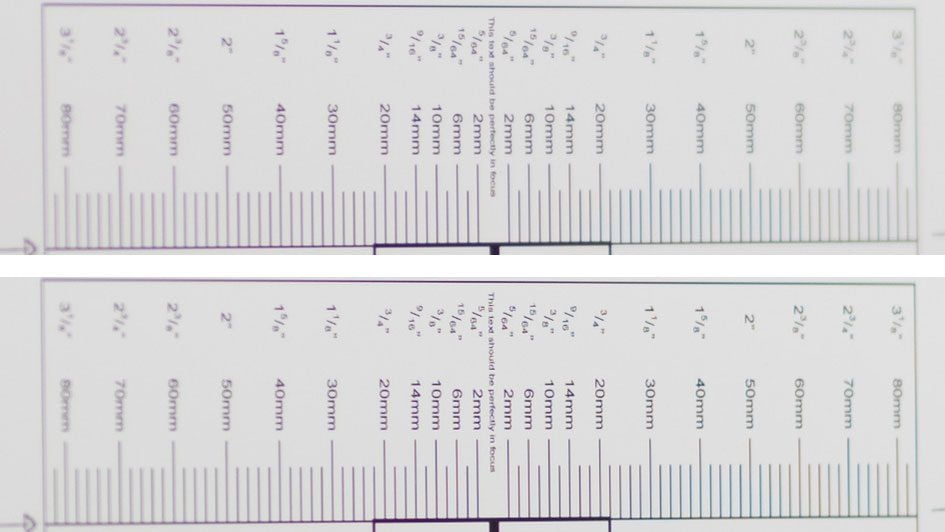
Above: Sigma 85mm f1.4 Art Longitudinal Chromatic Aberration (loCA). 100% crop, 85mm, f1.4 (top) and f2.0 (bottom), left = foreground, right = background
The following crops show that the Zeiss Otus (shot on a D800) produces less loCAs in comparison:
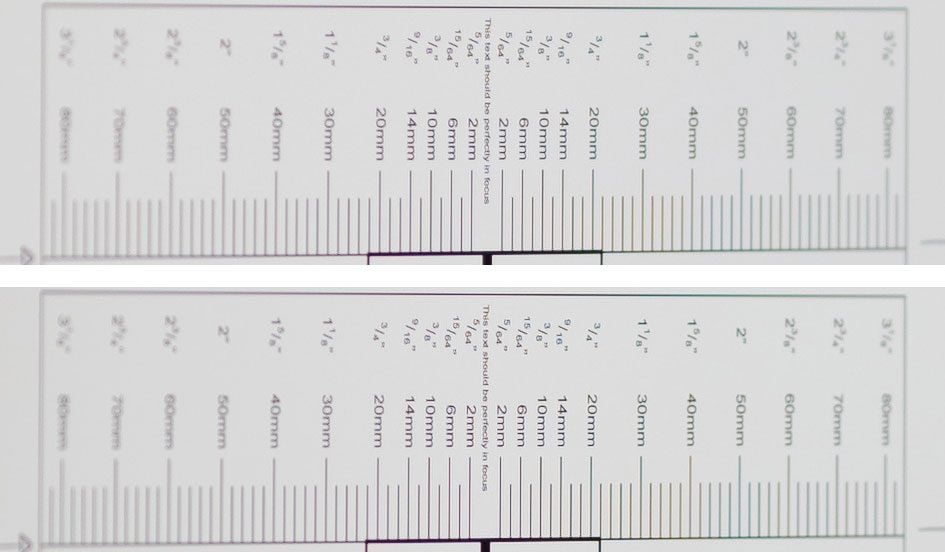
Above: Zeiss 85mm f1.4 Otus Longitudinal Chromatic Aberration (loCA). 100% crop, 85mm, f1.4 (top) and f2.0 (bottom), left = foreground, right = background
Axial colors also show up in real-life shots (see 100% crops below):

Above: Sigma 85mm f1.4 Art Longitudinal Chromatic Aberration (loCA). The fabric in the background does not contain any green; 1/60, f1.4, 64 ISO, 100% crop

Above: Sigma 85mm f1.4 Art Longitudinal Chromatic Aberration (loCA). Specular magenta highlight on the frame; 1/100, f1.4, 450 ISO, 100% crop

Above: Sigma 85mm f1.4 Art Longitudinal Chromatic Aberration (loCA). 1/400, f1.4, 64 ISO, 100% crop; Click image to access original at Flickr
I shot the same scene a few minutes later with the Zeiss Otus with identical exposure and white-balance:

Above: Zeiss 85mm f1.4 Otus Longitudinal Chromatic Aberration (loCA). 1/400, f1.4, 64 ISO, 100% crop; Click image to access original at Flickr
Sharpness and contrast
Let’s have a look at the theoretical performance of the new lens first compared to its predecessor, the Sigma 85mm f1.4 EX:
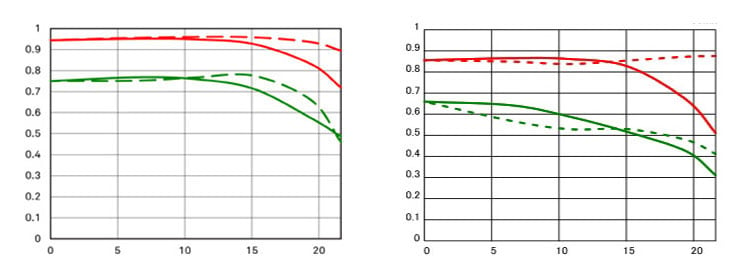
Above left: Sigma 85mm f1.4 Art MTF at f1.4, right: Sigma 85mm f1.4 EX MTF at f1.4
These charts show the lens-performance at the largest aperture. Higher values are better and the closer the dotted and the continuous lines of each color are together the less astigmatism (= resolution depends on the orientation of the test-pattern) the lens has. The x-axis displays the distance from the optical axis (=center of the sensor) in mm. I’ll show you the real-life performance at 4 mm (center), 13 mm (DX-corner), and 20 mm (FX-corner) on a D810.
From the charts, the new Sigma should perform much better than its predecessor. Both at 10 line-pairs/mm and at 30 line-pairs/mm the new Sigma Art shows a much higher contrast than its EX predecessor. This should clearly show in real life results in the sharpness test based on Siemens-stars.
What follows are near-center results (first column) followed by APS-C/DX-corner results and FF/FX-corner results on a D810. Processing was done in Lightroom 6.8 from RAW at Camera Standard settings. Noise-reduction is set to 0, sharpening to 35/0.5/36/10, with no extra tone, color, or saturation-adjustment. White-balance was adjusted to a neutral white and I did some exposure compensation to make the brightness match. CA-removal is ON.
The following are all 100% crops!

Above: Sigma 85mm f1.4 Art at 85mm, f1.4. 100% crop from center, APS-C/DX-corner, FF/FX-corner.

Above: Sigma 85mm f1.4 Art at 85mm, f2.0. 100% crop from center, APS-C/DX-corner, FF/FX-corner.

Above: Sigma 85mm f1.4 Art at 85mm, f2.8. 100% crop from center, APS-C/DX-corner, FF/FX-corner.

Above: Sigma 85mm f1.4 Art at 85mm, f4.0. 100% crop from center, APS-C/DX-corner, FF/FX-corner.

Above: Sigma 85mm f1.4 Art at 85mm, f5.6. 100% crop from center, APS-C/DX-corner, FF/FX-corner.

Above: Sigma 85mm f1.4 Art at 85mm, f8.0. 100% crop from center, APS-C/DX-corner, FF/FX-corner.

Above: Sigma 85mm f1.4 Art at 85mm, f11. 100% crop from center, APS-C/DX-corner, FF/FX-corner.

Above: Sigma 85mm f1.4 Art at 85mm, f16. 100% crop from center, APS-C/DX-corner, FF/FX-corner.
These 100% crops directly from a 36MP D810 sensor show that this lens delivers a very good performance across a full-frame sensor right from the start. The FF/FX-corner is especially noteworthy with almost no coma to be seen. It looks even just a little better than the APS-C/DX-corner which needs stopping down to f2.8 to become excellent. There was no need to optimize focus for the different crops: proof that the lens has no field-curvature to speak of. With such a sharp lens you can see diffraction start taking off the “bite” of the lens already at f8.0 if you look carefully.
Following is the performance of the Sigma 85mm f1.4 Art (1st row) directly compared to other lenses. Please note that the old Sigma 85mm f1.4 EX and the Nikon 85mm f1.4G were shot on a D800 which has a slightly softening AA-filter. I tried to compensate for this by using a stronger sharpening of 70/0.5/36/10 on those shots:

Above: Sigma 85mm f1.4 Art at 85mm, f1.4. 100% crop from center, APS-C/DX-corner, FF/FX-corner.

Above: Zeiss Otus 85mm f1.4 at 85mm, f1.4. 100% crop from center, APS-C/DX-corner, FF/FX-corner.

Above: Sigma 85mm f1.4 EX DG at 85mm, f1.4. 100% crop from center, APS-C/DX-corner, FF/FX-corner.

Above: Nikon 85mm f1.4G at 85mm, f1.4. 100% crop from center, APS-C/DX-corner, FF/FX-corner.

Above: Tamron SP 85mm f1.8 VC at 85mm, f1.8. 100% crop from center, APS-C/DX-corner, FF/FX-corner.

Above: Nikon 105mm f1.4E at 105mm, f1.4. 100% crop from center, APS-C/DX-corner, FF/FX-corner.
This comparison is proof that the Sigma is indeed an excellent performer. It’s only a little behind the mighty Zeiss Otus within the APS-C/DX image-circle and performs clearly better in the FF/FX-corner. The old Sigma 85mm f1.4 EX DG only claims last place in this comparison suffering from lower overall contrast and strong spherical aberrations even within the APS-C/DX image-circle. Sigma did right to update this lens to their “Art” design.
Performance at large distances
The Siemens-star test-targets are shot at a distance of 40x focal length (i.e. at 1.4m for 85mm focal length). But performance of lenses also depends on the shooting distance. Therefore I present another series of test-shots of a landscape dubbed the “Unremarkables” where you can measure distances in km, not meter. Processing was done in Lightroom 6.8 from RAW at Adobe Standard settings. Noise-reduction is set to 0, sharpening to 35/0.5/36/10, with no extra tone, or saturation-adjustment. There’s no tinkering with vignette-control so you see it here as it is produced by the lens. Focus was acquired at the largest aperture manually and not changed for other apertures.
You can click on each image to access the large original. Please respect our copyright and only use those images for personal use.
The main image shows the complete scene at f1.4 to give you an impression of the angle of view and to judge vignetting. This is followed by one row of 100% crops at different apertures each from near the middle, the DX/APS-C-corner, and the FX/FF-corner. You can access the respective shots up to f16 via the links beneath the main image.
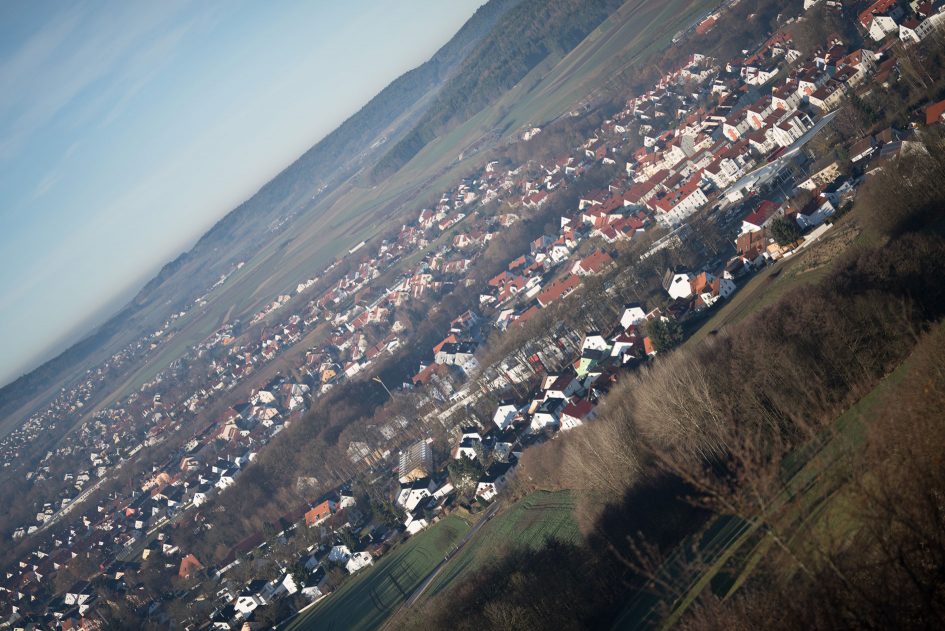
Above: Sigma 85mm f1.4 Art at 85mm, f1.4. Click image to access original at Flickr; also available at f2.0, f2.8, f4.0, f5.6, f8.0, f11, f16

Above: Sigma 85mm f1.4 Art at 85mm, f1.4. 100% crop from center, APS-C/DX-corner, FF/FX-corner.

Above: Sigma 85mm f1.4 Art at 85mm, f2.0. 100% crop from center, APS-C/DX-corner, FF/FX-corner.

Above: Sigma 85mm f1.4 Art at 85mm, f2.8. 100% crop from center, APS-C/DX-corner, FF/FX-corner.

Above: Sigma 85mm f1.4 Art at 85mm, f4.0. 100% crop from center, APS-C/DX-corner, FF/FX-corner.

Above: Sigma 85mm f1.4 Art at 85mm, f5.6. 100% crop from center, APS-C/DX-corner, FF/FX-corner.

Above: Sigma 85mm f1.4 Art at 85mm, f8.0. 100% crop from center, APS-C/DX-corner, FF/FX-corner.
Following is a comparison with the Zeiss 85mm f1.4 Otus shot only a few minutes later:

Above: Sigma 85mm f1.4 Art at 85mm, f1.4. 100% crop from center, APS-C/DX-corner, FF/FX-corner.

Above: Zeiss Otus 85mm f1.4 at 85mm, f1.4. 100% crop from center, APS-C/DX-corner, FF/FX-corner.
Performance of the Sigma wide open in this long-distance shots looks again very impressive up into the FF/FX-corner which profits from the very low coma of this lens. Compared to the Zeiss Otus the Sigma looks a bit less sharp in the center, equal in the APS-C/DX-corner and sharper in the FF/FX-corner. So optically the new Sigma is a very good performer near and far even surpassing the Otus in the corners of a full-frame sensor – which is a remarkable result!
Vignetting
To make it easier to compare light fall-off in the corners of a full-frame sensor I’ve arranged a series of three shots each with the Sigma (1st row) and the Zeiss Otus (2nd row) at different apertures. From left to right: f1.4, f2.0, and f2.8:
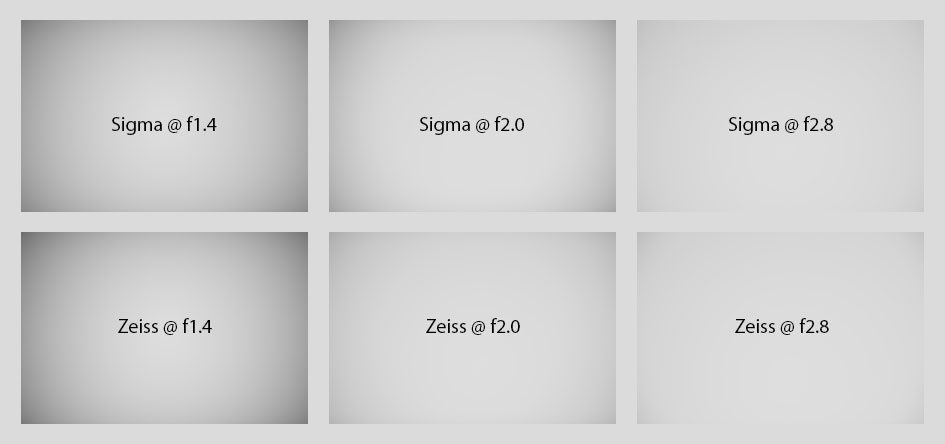
At f1.4 the Sigma has less vignetting than the Otus but at f2.0 the Zeiss 85mm f1.4 Otus is better.
Rendering of point-light sources at night-shots
Night-shots pose a different challenge for lenses as the contrast is even higher than under bright sun and point-light sources can reveal some weaknesses such as coma, haloing and color-aberrations that do not show up as prominently in other test-shots. The 100% crops below the main image show the effect of coma in the FF/FX corner of this lens at various apertures:
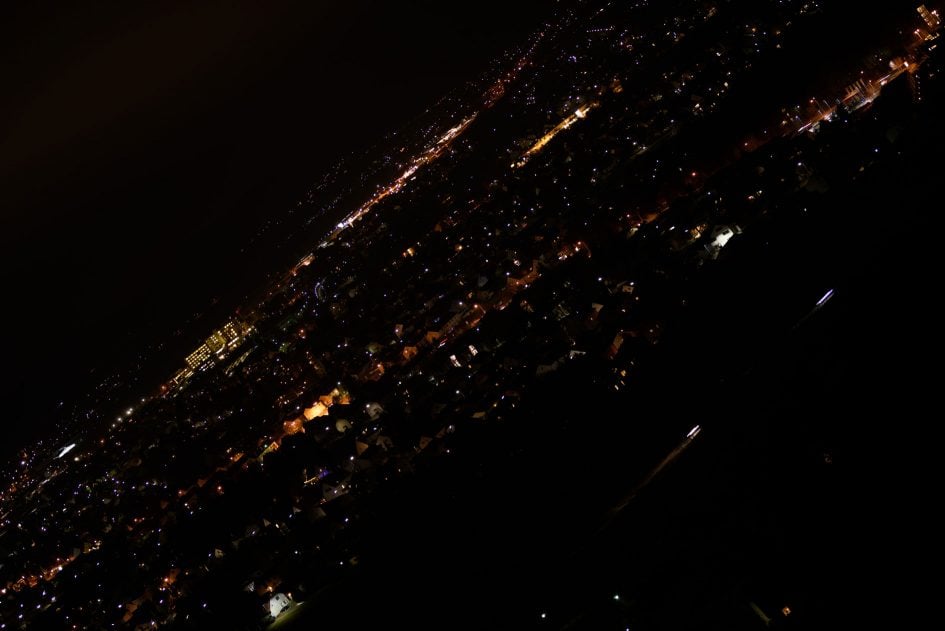
Above: Sigma 85mm f1.4 Art at 85mm, f1.4. Click image to access original at Flickr; also available at f2.0, f2.8, f4.0, f5.6, f8.0.

Above: Sigma 85mm f1.4 Art. FF/FX corner at f1.4, f2.0, f2.8
As demonstrated in the other tests above the lens has indeed a very good correction for coma. This is responsible for the excellent resolution in the FF/FX-corner.
Rendering of out-of-focus point-light sources
This test is for the rendering of point-light sources in an out-of-focus background. The circle of confusion that is produced by this test is pretty indicative of Bokeh performance (in the background) and light fall-off. Ideally the out-of-focus image of the point-light is evenly lit and perfectly circular, with no “onion-rings”, and without coloration. Large aperture lenses normally produce an effect known as “cat’s eye” the further away from the optical axis the point-light is projected. This is due to optical vignetting in the lens barrel when light enters the lens from an angle.
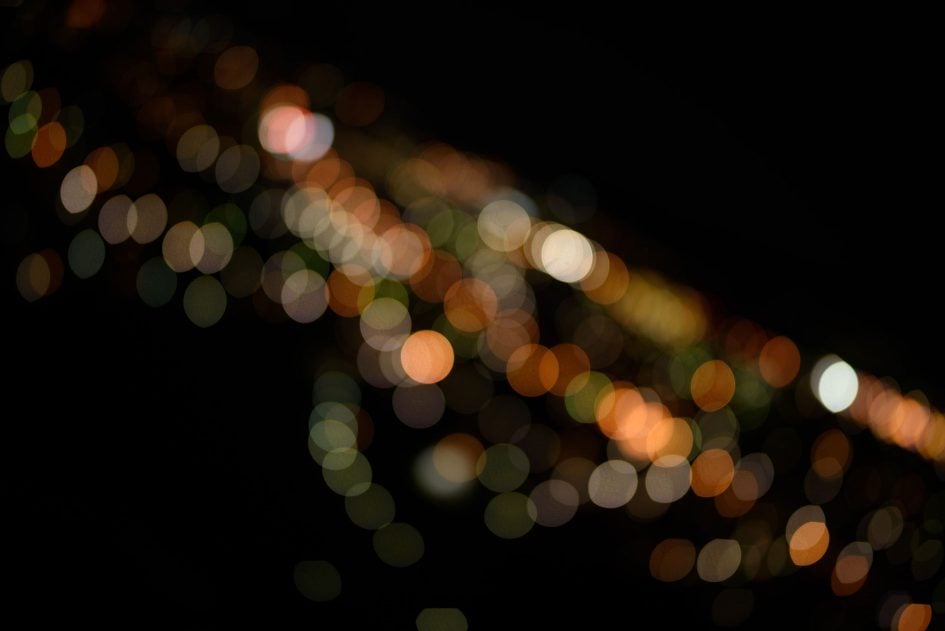
Above: Sigma 85mm f1.4 Art at 85mm, f1.4. Click image to access original at Flickr; also available at f2.0, f2.8, f4.0, f5.6, f8.0.

Above: Sigma 85mm f1.4 Art at 85mm, f1.4. 50% crop from center, APS-C/DX-corner, FF/FX-corner.
As the 50% crops above show: The Sigma 85mm f1.4 Art produces quite a nice circle of confusion. It’s big and exhibits no onion rings as befits a lens without aspheric elements. There’s only a weak, slightly green outline and light-distribution across the circle outside the optical axis is pretty even. But there’s a clear cat’s-eye effect towards the borders/corners of the sensor and some clipping from the mirror-box.
Following is a similar shot done at f1.4 with the Zeiss 85mm f1.4 Otus for comparison which produces similar results:

Above: Zeiss Otus 85mm f1.4 at 85mm, f1.4. 50% crop from center, APS-C/DX-corner, FF/FX-corner.
Now let’s see how this analysis of out-of-focus point-light sources translates into Bokeh-performance shooting a book-shelf.
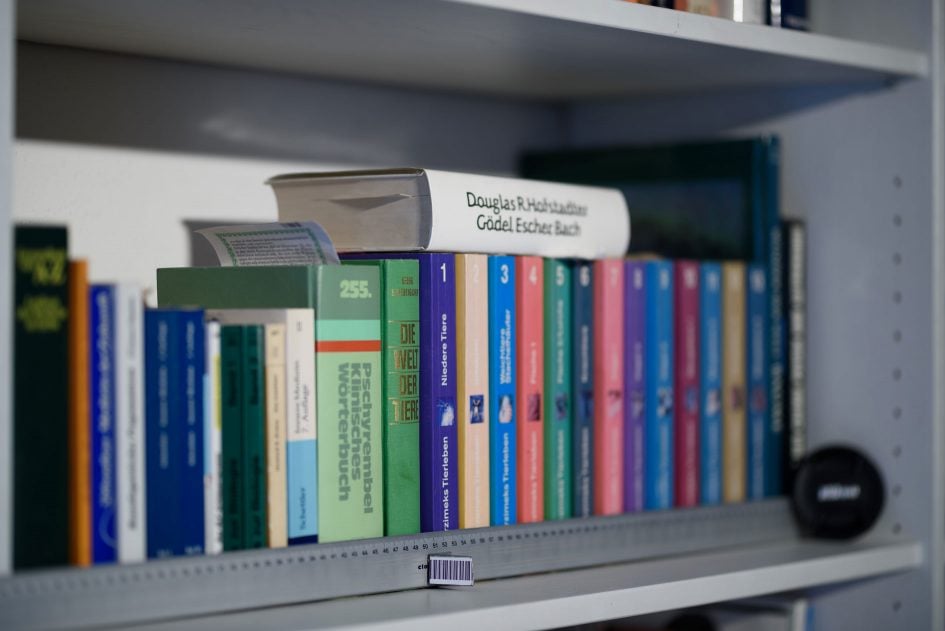
Above: Sigma 85mm f1.4 Art at 85mm, f1.4. Click image to access original at Flickr; also available at f2.0, f2.8, f4.0, f5.6, f8.0, f11.

Above: Sigma 85mm f1.4 Art at 85mm, f1.4. 50% crop from foreground, middle-ground, background
Let’s see how the Sigma 85mm f1.4 Art fares against other lenses:

Above: Zeiss Otus 85mm f1.4 at 85mm, f1.4. 50% crop from foreground, middle-ground, background

Above: Nikon 85mm f1.4G at 85mm, f1.4. 50% crop from foreground, middle-ground, background

Above: Tamron SP 85mm f1.8 VC at 85mm, f1.8. 50% crop from foreground, middle-ground, background

Above: Nikon 105mm f1.4E ED at 105mm, f1.4. 50% crop from foreground, middle-ground, background
The shot from the Zeiss Otus is also available at f2.0, f2.8, f4.0, f5.6, from the Nikon 85mm f1.4G at f2.0, f2.8, f4.0, f5.6, f8.0, from the Tamron at f2.0, f2.8, f4.0, f5.6, from the Nikon 105mm f1.4E at f2.0, f2.8, f4.0, f5.6, f8.0.
The Bokeh of the Sigma at f1.4 is the smoothest even compared to the Otus or the Nikon 105mm f1.4E. But it suffers a little from loCA around the plane of sharpest focus where the Otus is more neutral.
Flare/ghosting
Catching a strong light-source shining directly into the lens is always a risky business. It could produce strange colorful ghosts-images or reduce contrast considerably through flare and glare. The appearance of flare and ghosting depends on factors like the aperture and the angle of the light hitting the lens. So to judge the proclivity of the Sigma for these artifacts I went through a series of well calculated shots against a strong light source to provoke glare and ghosting. The lens hood was attached in all of these tests.
The results are very good wide open: there are only weak flares/ghosts and the blacks well away from the light source all really black. But stopping down produces some more visible artifacts: With the light inside the frame there is some stronger flare and ghosting (see left image below). And if the light is just outside the corner there is some glare (see image on the right below in the bottom-right corner):
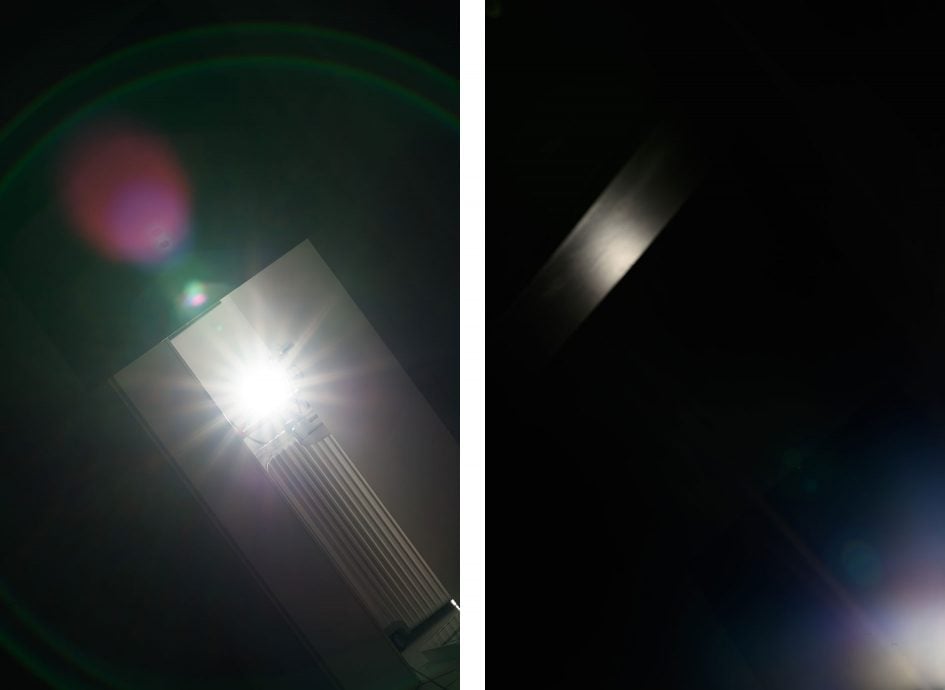
Above: Flare and ghosting. Strong light hitting the Sigma 85mm f1.4 Art at f8.0
When the light was clearly outside the frame (but still shining into the lens) there was only little flare or ghosting. All-in-all the lens shows a pretty good resistance to flare/glare/ghosting.
Check prices at Amazon, B&H, Adorama, eBay or Wex. Alternatively get yourself a copy of my In Camera book, an official Cameralabs T-shirt or mug, or treat me to a coffee! Thanks!



